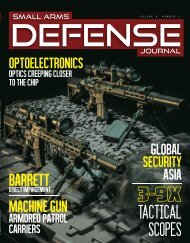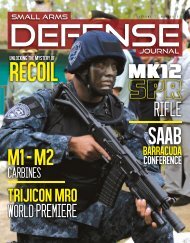SAR 18#6
Create successful ePaper yourself
Turn your PDF publications into a flip-book with our unique Google optimized e-Paper software.
Above Top: TNW’s carbine only charges from the right side, but the user can switch<br />
ejection to either left or right. The magazine release is the circular button toward the<br />
front of the magazine well. We found this release difficult to manipulate in a hurry, and<br />
easy to bump on accident while manipulating the weapon.<br />
Above Bottom: The Thureon GA carbine places the ejection port and charge handle on<br />
opposite sides. The right handed gun is “charged” with the left hand. The scope rail and<br />
receiver are machined from a single billet. We appreciate the oversized ejection port as<br />
it makes for easy visual inspection and, if need be, the operator can get a tool inside to<br />
clear a malfunction.<br />
fired a high velocity low impulse cartridge,<br />
featured large magazine capacities,<br />
and automatic fire capabilities;<br />
but only after the submachine gun had<br />
proven its worth. The assault rifle was<br />
only a logical next step for the SMG; it<br />
had greater effective range. The German<br />
MP43(44) and STG 44 assault<br />
rifles were the immediate descendants<br />
of the submachine gun. Today’s military<br />
and law enforcement have kept the submachine<br />
gun in service; mostly among<br />
SWAT and Special Forces units. The<br />
most notable and successful examples<br />
would be the ubiquitous Heckler & Koch<br />
MP5 from Germany and the infamous<br />
Uzi, from Israel. Most people would be<br />
hard-pressed to name any others. But<br />
can the average “Joe” get his hands on<br />
an SMG? The high price and legal restrictions<br />
on a transferrable submachine<br />
gun pushes many consumers out of<br />
that market. The closest many will get<br />
to owning one will come in the form of<br />
a semiautomatic pistol caliber carbine;<br />
referred to herein as a “PCC.”<br />
Many major arms maker have offered<br />
a PCC at one time or another.<br />
Ruger and Marlin both made excellent<br />
PCCs in years past. Beretta, Calico,<br />
Kel-Tec, and Hi-Point offer their own<br />
unique PCCs – all incorporating very<br />
advanced design and materials. The Auto-Ordnance<br />
Thompson, Kriss Vector,<br />
FN PS90, and the HK 94 (and clones)<br />
represent true submachine guns that<br />
have been recreated in non-NFA configurations<br />
for the civilian market. Do-ityourselfers<br />
have fostered a huge market<br />
for rebuilding old war surplus guns from<br />
parts kits. Salvaged Sten, Sterling, and<br />
Suomi semiautomatics have become<br />
quite common. There exists a family of<br />
devices that can be affixed to an existing<br />
handgun to render it a carbine; suggesting<br />
improved accuracy and handling<br />
characteristics that exceed the basic<br />
pistol. These are available from companies<br />
like FAB Defense, Command Arms<br />
Accessories, Hera Arms, MechTech and<br />
SIG Sauer. All but the MechTech employ<br />
the pistol’s existing short barrel, and require<br />
an NFA tax stamp for legal use.<br />
And the inherent accuracy, range, and<br />
effect of the pistol are not necessarily<br />
enhanced by simply adding a stock.<br />
Some firms that manufacture the AR-15<br />
produce the AR rifle in pistol calibers.<br />
They either create a new receiver to<br />
accept the pistol magazine, or install a<br />
magazine adapter. The barrel, bolt, and<br />
some internal parts are also replaced in<br />
these converted rifles. But the platform<br />
is not purpose-built, and the resultant rifle<br />
maintains the size and weight of the<br />
basic AR-15. At times, this is desirable,<br />
<strong>SAR</strong> Vol. 18, No. 6 86 Nov., Dec. 2014









